Medicines expire because their chemical stability declines over time, causing active ingredients to break down or change. Factors like heat, humidity, light, and oxygen speed up these reactions, leading to reduced effectiveness or harmful byproducts. Proper storage can slow this process, but eventually, the medicine’s chemical bonds weaken. To understand how scientists develop ways to extend shelf life and ensure safety, keep exploring the chemistry behind drug stability.
Key Takeaways
- Medicines expire because their active ingredients gradually degrade, losing potency and effectiveness over time due to chemical reactions.
- Chemical processes like oxidation and hydrolysis break molecular bonds, altering drug structure and producing potentially harmful byproducts.
- Factors such as heat, light, humidity, and oxygen accelerate chemical reactions, speeding up drug degradation and expiration.
- Proper storage conditions slow chemical changes, helping medicines maintain stability and safety until their expiration date.
- Once chemical stability diminishes, the medicine may become ineffective or unsafe, prompting expiration to ensure patient safety.
Understanding the Concept of Chemical Stability in Medicines
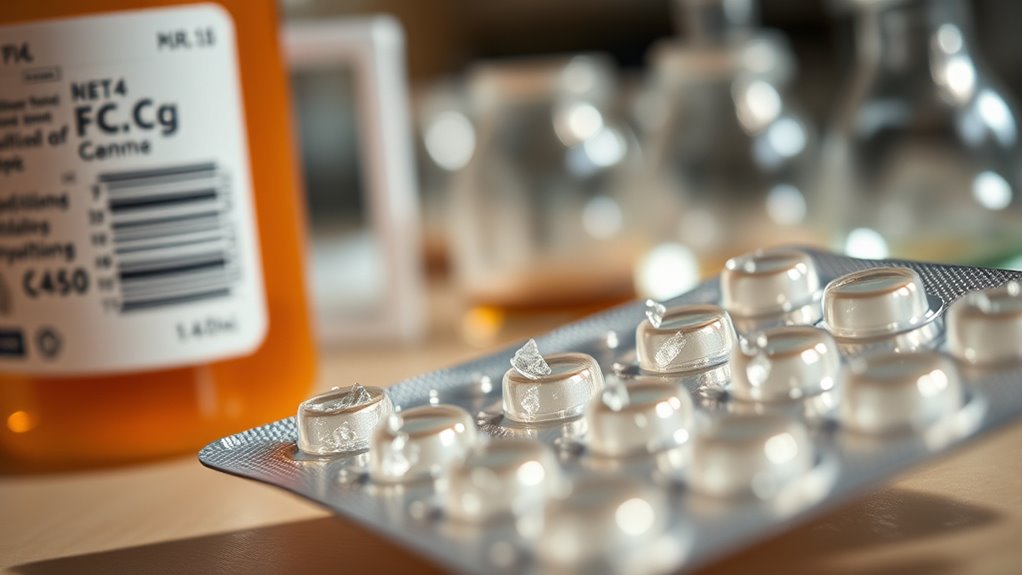
Understanding chemical stability in medicines means recognizing how active pharmaceutical ingredients (APIs) maintain their molecular structure and potency over time. You need to know that stability involves resisting chemical reactions like hydrolysis and oxidation, which can break down or alter the drug. Proper storage and handling conditions are crucial to prevent these reactions from occurring. Ensuring stability is a regulatory requirement because it guarantees the medicine’s safety and effectiveness throughout its shelf life. This concept isn’t just about chemical integrity; it’s part of broader stability, including physical, microbiological, and therapeutic aspects, ensuring overall quality. Stability testing confirms how long a medicine remains effective under specified conditions. If the API degrades, it can lead to reduced potency, formation of harmful byproducts, or changes in how the drug works, all threatening patient safety and treatment success. Additionally, understanding drug stability mechanisms helps in developing better formulations that resist degradation during storage and use.
How Storage Conditions Affect Drug Longevity
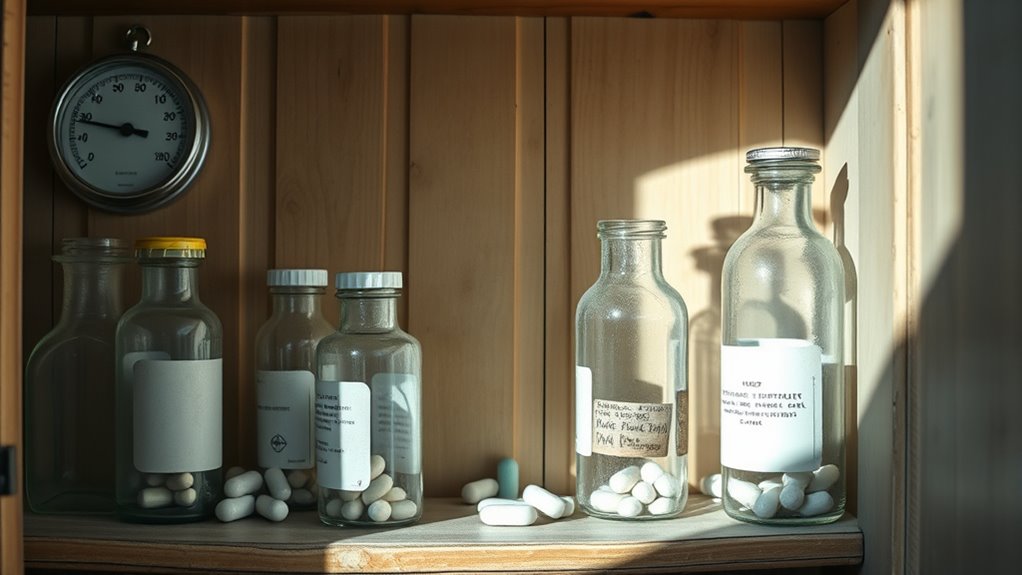
Proper storage conditions are crucial for maintaining a drug’s effectiveness over time. When you store medicines improperly, heat, humidity, and light can speed up chemical breakdown, reducing potency. High temperatures accelerate reactions; for example, Diazepam loses potency faster at 37°C. Humidity causes moisture absorption, especially in tablets and powders, leading to degradation. Light exposure triggers photodegradation, weakening drug strength. Packaging also plays a vital role—original, protective containers shield medications from environmental stressors. Consider the following factors:
| Temperature | Humidity | Light Exposure |
|---|---|---|
| Accelerates chemical reactions | Causes moisture absorption | Causes drug breakdown |
| Reduces shelf life | Especially harmful to powders | Requires opaque packaging |
| Refrigeration slows degradation | Proper packaging essential | Protects drug potency |
Storing your medicines correctly ensures they remain safe and effective longer. Proper storage also helps prevent medication spoilage and ensures the drug maintains its intended chemical stability.
The Role of Chemical Composition Changes Over Time
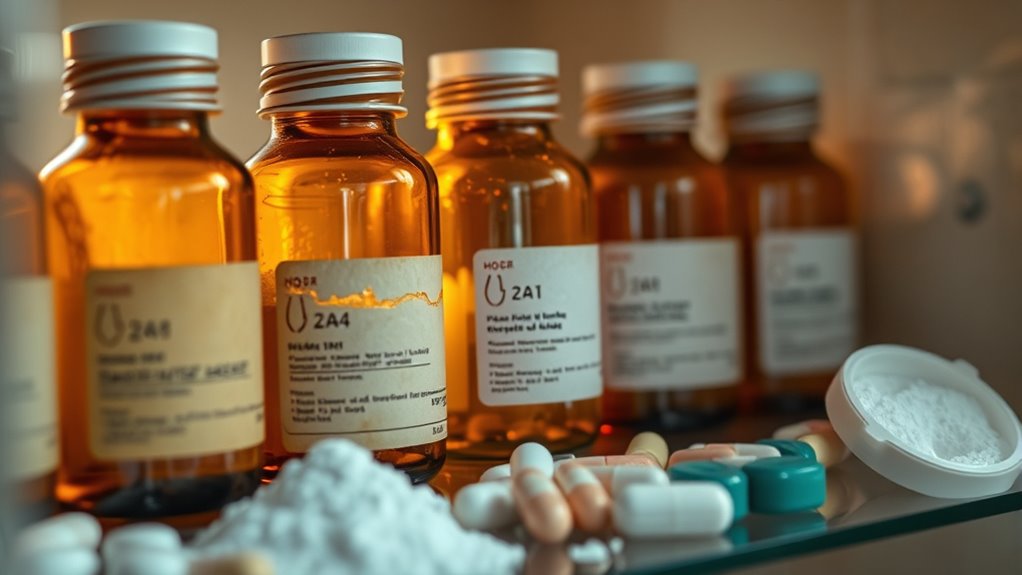
Over time, a drug’s chemical composition can change due to various degradation processes, directly impacting its stability and effectiveness. These changes involve breaking or forming chemical bonds, which alter the drug’s molecular structure. Understanding these processes helps in designing better storage conditions and formulations. When active pharmaceutical ingredients (APIs) degrade, their potency diminishes, and their pharmacological effects may change. Sometimes, degradation produces harmful byproducts that can be toxic or unsafe. Oxidation, where molecules gain oxygen or lose electrons, is a common cause, often triggered by light, heat, or metal contaminants. Hydrolysis, involving water, breaks down functional groups like esters or amides, reducing active ingredients. These chemical alterations can lead to inconsistent dosing, decreased efficacy, and safety concerns, emphasizing the importance of understanding how composition shifts affect drug stability over time. Proper storage conditions, such as controlled temperature and protection from light, are crucial to minimize these chemical changes and maintain drug effectiveness.
Factors That Accelerate Drug Degradation

Various environmental and chemical factors can markedly speed up drug degradation, affecting their stability and effectiveness. High temperatures increase reaction rates, causing faster breakdown, while low temperatures may lead to crystallization or denaturation of proteins. Humidity promotes moisture absorption, softening or caking powders and encouraging microbial growth and chemical reactions. Temperature not only influences the rate of chemical reactions but also impacts physical stability, making temperature control vital during storage. Light exposure, especially for photosensitive medicines, accelerates degradation, so storing drugs in dark conditions helps preserve potency. Oxygen reacts with certain drugs, leading to oxidation and chemical deterioration. Changes in pH can destabilize drugs sensitive to acidic or basic environments. Chemically, catalysts like acids, bases, and redox agents speed up reactions. Solvent choice, ionic strength, and polymer interactions also influence degradation, making storage conditions essential for maintaining drug stability over time. Additionally, chemical stability can be affected by impurities present in the drug formulation, further complicating storage requirements.
The Impact of Supply Chain Management on Medicine Shelf Life

Effective supply chain management plays a crucial role in extending the shelf life of medicines by ensuring they are stored, transported, and handled under ideal conditions. Implementing practices like First Expiry First Out (FEFO) helps prioritize distribution of near-expiry drugs, reducing waste. Tracking systems with alert functions enable you to proactively manage upcoming expiry dates, facilitating timely redistribution or disposal. Repackaging and relabelling strategies can extend effective shelf life or clarify expiry info for users. Additionally, strict quality control during handling preserves drug stability. Regulatory requirements also influence inventory practices, pushing for minimum shelf life standards at shipment. Proper storage conditions—climate control and packaging—are essential to prevent premature degradation. Research shows that maintaining optimal storage environments significantly impacts drug stability and shelf life. Ensuring compliance with storage standards is vital for maintaining medicine efficacy during transportation and storage. Here’s a quick overview:
| Practice | Benefit | Key Point |
|---|---|---|
| FEFO policy | Reduces waste | Distributes products nearing expiry |
| Tracking with alerts | Timely management | Prevents unnoticed expiration |
| Proper storage | Maintains stability | Preserves drug efficacy |
Common Drug-Specific Concerns Related to Expiration
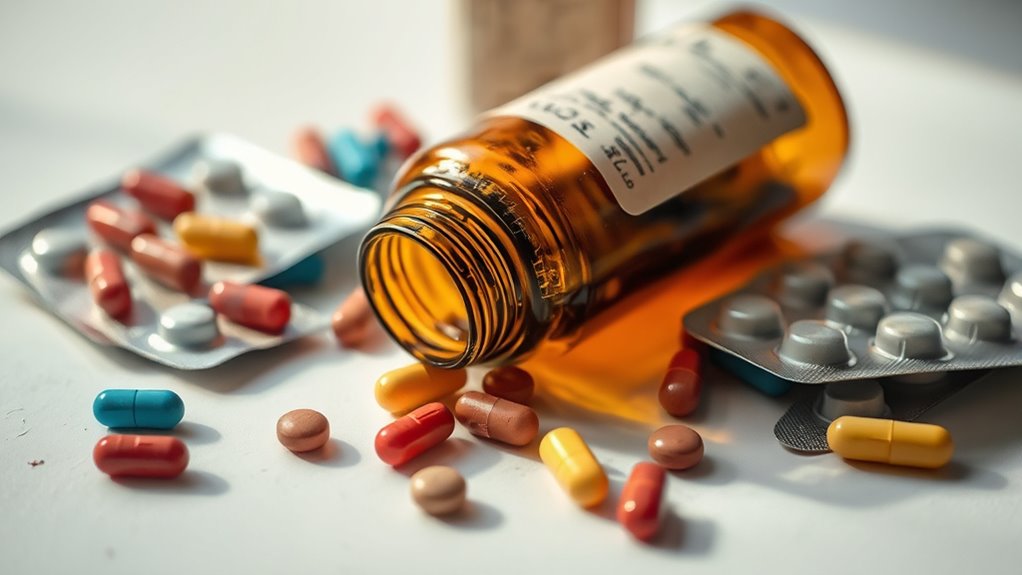
Have you ever wondered why certain medicines lose their effectiveness more quickly after their expiration date? Different drugs have unique stability concerns. For example, insulin degrades rapidly, reducing its blood sugar control, while nitroglycerin can lose potency after opening, needing replacement near expiration. Antibiotics like tetracyclines may produce harmful breakdown products if outdated, and chemotherapy agents or anticonvulsants can deteriorate, risking underdosing or toxicity. Stability varies widely among drug types, influenced by their chemical structures and formulation. Vaccines and biologicals are especially sensitive; their molecular structures can break down quickly beyond expiration, reducing efficacy. Proper storage conditions help, but once a medicine shows signs of deterioration, it’s safest to discard it. Proper storage is crucial to maintaining drug stability and efficacy over time.
Strategies for Effective Inventory Management and Rotation
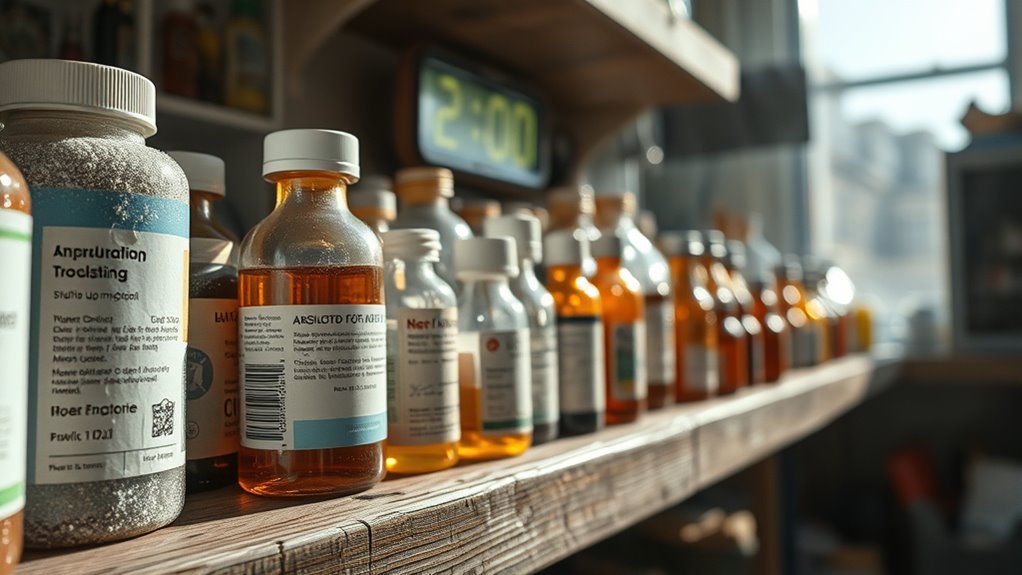
Implementing robust inventory management and rotation strategies is essential to guarantee medication waste reduction and assure patient safety. Automated systems with barcode scanning and real-time tracking minimize human error and keep you updated on expiration dates. Freshness indicators can help identify spoiled medications early, further supporting safety. Cloud platforms sync stock levels across locations, while automated reordering maintains ideal inventory. Compliance tools help track lot numbers and generate audit trails, simplifying regulatory adherence. Using data-driven methods like sales analysis and seasonal trend forecasting allows you to adjust stock levels proactively. Regular audits, including cycle counts and expiration date reviews, catch nearing expiry medications early. FEFO protocols—automated alerts, visual markers, and batch segregation—prioritize older stock for dispensing. These strategies streamline inventory control, reduce waste, and uphold safety standards efficiently.
The Chemistry Behind Extended Shelf Life and Stability Research
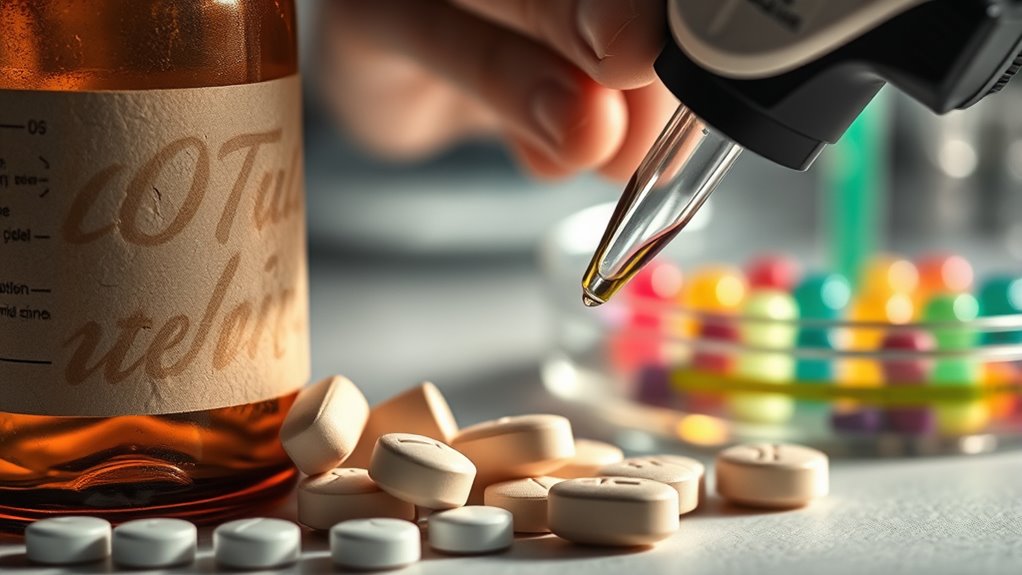
Understanding the chemistry behind drug stability is essential for extending shelf life and ensuring medication safety. Researchers analyze how factors like chemical composition, pH, water content, and storage conditions influence degradation. Stability testing monitors potency, physical appearance, and impurities, guiding shelf life decisions. Advances like the SLEP program show many drugs remain effective well beyond expiration dates, with some stable over 15 years. Packaging and preservatives also play key roles in maintaining stability. Here’s a visual overview:
| Factor | Chemical Reaction | Impact on Stability |
|---|---|---|
| Hydrolysis | Water breaks bonds | Decreases potency |
| Oxidation | Reaction with oxygen | Forms harmful impurities |
| pH Levels | Alters molecular stability | Accelerates degradation |
| Moisture Content | Excess moisture | Promotes degradation |
| Preservatives | Prevent microbial growth | Extends shelf life |
This research informs regulatory approvals and improves drug safety. Additionally, understanding drug stability mechanisms helps develop better storage guidelines and packaging solutions to prolong effectiveness.
Future Innovations in Ensuring Medicine Potency and Safety

Advancements in drug delivery systems are revolutionizing how you preserve and administer medicines. Nanoparticle carriers enhance drug stability and enable controlled release, keeping medicines potent longer. Encapsulation techniques shield sensitive drugs from moisture and light, reducing degradation.
Implantable devices provide localized, sustained release, cutting down dosing frequency and maintaining efficacy. Smart delivery systems respond to physiological triggers, releasing medication only when needed, which minimizes waste. Innovations like oral thin films and patches improve bioavailability and shelf life by avoiding gastrointestinal breakdown.
Additionally, smart packaging with moisture scavengers, RFID tracking, and self-healing materials actively protect medicines during storage. High refresh rates and other technological advances are also being integrated into delivery systems to optimize performance. Combining these innovations with AI-driven predictions and novel preservation methods ensures your medicines remain safe, effective, and reliable well beyond their expiration dates.
Frequently Asked Questions
How Do Preservatives Influence the Stability and Expiration of Medicines?
Preservatives play a key role in keeping medicines stable by preventing microbial growth, which can compromise safety and efficacy.
Over time, preservatives may degrade due to factors like temperature, humidity, or light exposure, reducing their effectiveness. This degradation can lead to contamination and a shorter shelf life.
Can Different Formulations of the Same Drug Have Varying Expiration Dates?
You might think all formulations of the same drug expire at the same time, but that’s not true. Different formulations, like tablets, liquids, or creams, contain varied inactive ingredients and physical properties, impacting stability.
Storage conditions and packaging also play roles. So, even if it’s the same drug, the expiration date can differ based on how it’s made and stored, ensuring its effectiveness remains safe for use.
What Role Does Ph Play in Drug Stability Over Time?
You should understand that pH plays a vital role in drug stability over time. It affects how drugs ionize, which influences their chemical stability and potential degradation.
Maintaining the proper pH prevents hydrolysis and oxidation, which can break down the drug and reduce its effectiveness.
Regular pH monitoring and using buffer systems help keep drugs stable during storage, ensuring they remain safe and effective until their expiration date.
How Do Packaging Materials Affect Medicine Shelf Life?
Packaging materials act like a fortress guarding your medicines, extending their life by blocking harmful elements. Light-blocking materials keep photosensitive drugs safe, while moisture-resistant coatings prevent hydrolysis and microbial growth.
Oxygen scavengers reduce oxidation, and multi-layered packaging combines barriers for maximum protection. These materials guarantee your medication remains effective, stable, and safe throughout its shelf life, acting as silent guardians that preserve potency until you need them.
Are There Natural or Alternative Methods to Extend Drug Stability?
You can use natural and alternative methods to extend drug stability by exploring nanotechnology, which uses nanocoatings to protect active ingredients from environmental damage. Herbal formulations with nano dosage forms improve solubility and bioavailability, while natural preservatives help prevent microbial growth.
Additionally, advanced packaging, optimized storage conditions, and innovative delivery systems like liposomes and controlled release methods further enhance stability, reducing degradation and prolonging shelf life naturally and effectively.
Conclusion
Understanding why medicines expire is like peeling back the layers of a complex puzzle. By knowing how chemical stability, storage, and ingredients change over time, you can better protect yourself from ineffective or unsafe drugs. Proper storage and inventory management act as shields against degradation, keeping medicines potent and safe. Think of it as tending a garden—you must nurture and care for your supplies to ensure they remain effective, not wilted by the passage of time.









